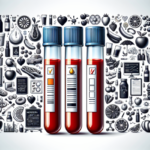Unlocking the Power of Blood Test Units for Effective Health Management
To successfully navigate your health journey, it is essential to have an in-depth understanding of blood test units. These units represent the fundamental language through which healthcare professionals convey critical information regarding your body's functionality. Each test result is displayed in specific units, which quantify the concentration of various substances found in your blood. This quantification is pivotal for accurate diagnosis, effective treatment strategies, and comprehensive health management. Therefore, it is important for individuals to familiarize themselves with these terminologies to actively participate in their health journey.
Understanding Blood Test Units for Accurate Health Evaluations

To fully grasp the significance of blood test units, it is crucial to comprehend how these measurements are represented. Blood tests are designed to evaluate quantities, measuring levels of vital components like glucose, cholesterol, and electrolytes. The specific units utilized can differ based on the substance being measured, which is fundamental for determining whether a particular level is within a healthy range or indicates potential health issues requiring intervention. Gaining familiarity with these terms empowers individuals to engage proactively with their health data.
In general, blood test units can be categorized into two primary types: those that measure concentration (like grams per liter or millimoles per liter) and those that indicate mass (such as milligrams per deciliter). For example, in the United States, glucose levels are frequently reported in milligrams per deciliter (mg/dL), while many other nations use millimoles per liter (mmol/L). Understanding these differences is vital, as they can significantly influence the interpretation of test results and the healthcare decisions made as a result.
Moreover, these units provide a standard framework for health assessments across diverse populations, ensuring that healthcare providers can communicate results in a consistent and reliable manner. This uniformity ultimately enhances patient care and understanding, fostering a more informed approach to health management, and empowering patients to take proactive steps in their healthcare journeys.
Common Blood Test Units Encountered in Medical Practice
Within the extensive realm of blood test units, certain units are more commonly encountered in medical practice. The most prevalent include:
– Millimoles per liter (mmol/L): This unit is extensively used for measuring glucose and cholesterol, particularly in metric system-adopting countries, providing an accessible means to interpret crucial health metrics.
– Milligrams per deciliter (mg/dL): Primarily utilized in the United States for assessing glucose and cholesterol levels. Recognizing the distinctions between these two units is essential for accurate health evaluations and understanding, as misinterpretation can lead to significant health risks.
International Units (IU): Commonly employed for vitamins and hormones, this unit measures a substance’s biological effect rather than its mass, underscoring the diverse applications of blood test units in understanding physiological processes.
Each of these units carries unique significance in the tests performed. For instance, a glucose level of 5.6 mmol/L is deemed normal, but if the same reading is at 100 mg/dL, it might lead to different interpretations if unit conversions are not understood. This knowledge is crucial for anyone aiming to take control of their health and make sound decisions.
Essential Skills for Converting Blood Test Units Accurately
Grasping the ability to convert between various blood test units is fundamental for both patients and healthcare providers. Being proficient in these conversions can provide vital clarity when interpreting test results, enhancing communication between patients and healthcare professionals.
To convert glucose levels from mmol/L to mg/dL, the standard approach is to multiply the value by 18. Conversely, for converting from mg/dL to mmol/L, one should divide by 18. For example, a glucose reading of 6 mmol/L approximately translates to 108 mg/dL. This mathematical comprehension empowers patients to actively engage in their health management discussions with healthcare providers, thereby enhancing their overall health literacy.
Various online calculators and conversion charts are readily available, making it simpler for individuals to perform these conversions with confidence. Familiarizing oneself with these tools can significantly improve the quality of discussions with healthcare professionals, ultimately leading to more informed and productive conversations about health and well-being.
Key Strategies for Effectively Navigating Blood Test Units

Understanding blood test units is crucial for accurately interpreting test results and gaining valuable insights into one’s health status. These units play a vital role in diagnosing various health conditions, facilitating correct interpretations of health status, and guiding appropriate interventions.
The Important Role of Blood Test Units in Health Diagnosis and Management
The diagnostic process is heavily reliant on accurate measurements of substances within the blood. Each <a href="https://bloodtest.co.uk/mastering-blood-test-lab-skills-your-essential-guide/">blood test unit</a> serves as a key tool for healthcare professionals to evaluate health conditions. For instance, elevated levels of cholesterol reported in mg/dL may indicate a heightened risk of heart disease, while abnormal glucose levels could hint at the presence of diabetes, necessitating further investigation.
Healthcare professionals utilize these units to establish reference ranges that define what is considered ‘normal’ for healthy individuals. When test results fall outside these established ranges, it may signal underlying health issues that require additional scrutiny. Therefore, understanding the relevance of units is crucial, as they reflect an individual’s current health status and guide necessary interventions and treatment plans.
Furthermore, a comprehensive understanding of these units aids in the early detection of diseases, which can lead to more effective treatment outcomes. Patients are encouraged to familiarize themselves with the relevant units associated with their health assessments and interpretations of blood test results, empowering them to take an active role in their health management.
Interpreting blood test units requires a nuanced perspective. Each test result should be evaluated in the context of the individual’s health history, symptoms, and other pertinent factors. For instance, a slightly elevated liver enzyme level may not be concerning when viewed alone; however, when considered alongside additional symptoms, it could indicate a more serious condition that necessitates immediate attention from healthcare professionals.
Moreover, factors such as age, gender, and lifestyle can significantly influence what is regarded as normal. Healthcare providers often consider these elements when discussing results with patients, offering a holistic view of health rather than just numerical values, ensuring that all aspects of health are taken into account.
Patients should feel empowered to ask questions regarding their results. Understanding what each unit signifies and how it correlates with overall health enables individuals to take an active role in managing their health effectively and making informed choices.
Identifying Emerging Trends in Blood Test Units

The field of blood test units is constantly evolving, with new trends emerging in standardization and technological enhancements. Recently, there has been a concerted effort to adopt more universally accepted units to reduce confusion, especially in internationally operated healthcare settings where consistency is crucial for accurate diagnoses and treatment.
Additionally, advancements in technology have resulted in the development of more sophisticated testing methods, leading to improved accuracy and reliability of measurements. For example, the introduction of point-of-care testing devices allows for immediate feedback on blood test results, facilitating quicker decision-making in clinical environments and enhancing patient outcomes.
These trends not only improve the quality of patient care but also promote a better understanding of health metrics among patients. As the healthcare landscape evolves, remaining informed about these changes becomes increasingly vital for both patients and professionals, ensuring they are equipped to navigate the complexities of health management.
Practical Applications of Blood Test Units in Everyday Life
Gaining knowledge about blood test units extends far beyond theoretical understanding; it has tangible implications for daily health monitoring and management, profoundly affecting overall well-being.
Leveraging Blood Test Units for Ongoing Health Monitoring
Individuals can apply blood test units for continuous health tracking, as regular testing can yield valuable insights into one’s health status. This proactive management approach enables individuals to make necessary lifestyle adjustments and effectively monitor their conditions. For example, tracking blood glucose levels is especially advantageous for those at risk of developing diabetes, allowing for timely interventions.
Home testing kits have become widely accessible, providing individuals with the convenience of checking their levels at home. By understanding the units associated with these tests, users can accurately interpret their results, enabling them to make informed dietary or medication changes based on their readings, thereby enhancing their self-management capabilities.
Furthermore, maintaining a health log to track these units over time can reveal trends, helping users identify potential health issues before they escalate. This level of engagement empowers individuals and enriches communication with healthcare providers, leading to more personalized health strategies tailored to their specific needs and circumstances.
Interpreting Blood Test Units in Relation to Nutrition and Fitness
Blood test units provide pivotal information for fitness enthusiasts and individuals focused on nutrition, guiding dietary changes and training schedules. For example, athletes often monitor their electrolyte levels, which can vary significantly during intense training sessions, ensuring they maintain optimal performance.
Understanding these units is essential for maximizing performance. Runners, for instance, may track their sodium levels to avert dehydration, ensuring peak performance during races. Likewise, monitoring blood sugar levels can assist athletes in determining optimal meal timing and composition, boosting energy levels and enhancing recovery, ultimately benefiting their training regimens.
Nutritionists and personal trainers frequently utilize these metrics to devise customized fitness plans that align with each individual’s unique requirements. By incorporating blood test units into their fitness and nutrition strategies, individuals can more effectively reach their health goals and enhance overall performance, creating a personalized approach to wellness.
Blood Test Units as Essential Tools in Chronic Disease Management
For individuals managing chronic conditions such as diabetes or heart disease, blood test units are invaluable instruments. Regular monitoring of critical metrics facilitates timely interventions and adjustments to treatment protocols. For instance, diabetic patients must routinely check their blood glucose levels to maintain them within targeted ranges, ensuring effective disease management.
Grasping the implications of units in these contexts enables patients to take control of their health management. By recognizing when values are excessively high or low, individuals can make informed decisions regarding necessary medication adjustments or dietary changes, fostering a proactive approach to their health.
Healthcare providers can use this data to tailor treatments effectively, thereby enhancing patient outcomes. This proactive health management approach underscores the importance of being well-acquainted with test units to understand health results and their implications, ultimately improving the quality of care received.
Addressing Common Inquiries About Blood Test Units
As discussions surrounding blood test units continue to evolve, numerous questions often arise that require clarification to enhance understanding, benefiting both patients and healthcare providers.
What Do Various Blood Test Units Indicate?
Different blood test units correspond to specific substances measured in the blood. For instance, glucose levels are commonly measured in mg/dL or mmol/L, while cholesterol is typically reported in mg/dL. Understanding these units is essential for accurately interpreting one’s health status and guiding necessary interventions.
How Can I Accurately Interpret Blood Test Results?
Accurately reading blood test units requires an understanding of the reference ranges associated with each test. These ranges indicate what is considered normal. Patients should also consider their unique health factors, as individual circumstances can significantly influence the interpretation of results, enhancing their overall health literacy.
Do Blood Test Units Differ by Country?
Indeed, blood test units can vary significantly from one country to another. For example, while glucose levels are generally reported in mg/dL in the United States, many other countries prefer using mmol/L. This discrepancy highlights the importance of understanding the specific units applicable in your region to avoid misinterpretation and improve health outcomes.
Diving Deeper into Advanced Concepts of Blood Test Units
Exploring blood test units reveals a wealth of scientific principles and future developments that are crucial for enhancing healthcare practices.
The Scientific Foundations of Blood Test Units
Understanding the scientific basis of blood test units involves examining the biochemical processes that dictate how substances are quantified in the blood. Each unit reflects specific molecular weights and concentrations, which are essential for accurate testing and diagnosis, ensuring that healthcare providers can deliver precise care.
Moreover, advancements in testing methodologies often rely on rigorous scientific research, ensuring that results are accurate and applicable in clinical settings. This scientific foundation is vital for the continuous enhancement of testing protocols and methodologies in healthcare, ultimately benefiting patients.
Laboratory Standards Governing Blood Test Units
Laboratory standards play a critical role in ensuring the accuracy of blood test units. Regulatory agencies establish guidelines that laboratories must follow, ensuring consistency in test execution and the reliability of results. These standards mitigate variations that could otherwise lead to misdiagnosis or inappropriate treatment protocols, improving overall healthcare quality.
Additionally, technological advancements have encouraged laboratories to adopt more sophisticated methodologies, enhancing the precision and dependability of test results. Consequently, staying informed about these standards is crucial for both healthcare professionals and patients navigating the complexities of blood test units, promoting optimal health outcomes.
Anticipating Future Developments in Blood Test Units
Looking ahead, the future promises exciting advancements in blood test units. Innovations in technology, such as the integration of artificial intelligence into diagnostic processes, may lead to more personalized and accurate testing. Furthermore, the standardization of units across countries could simplify health assessments for individuals who travel or reside abroad, enhancing global health practices.
As research continues to evolve, the future of blood testing holds tremendous potential for improved health outcomes and more accessible healthcare for all individuals, ensuring that everyone can benefit from advancements in medical science.
Real-World Applications of Blood Test Units: Case Studies and Illustrations
Practical applications of blood test units can provide valuable insights into their significance and utility in daily life, making health management more effective.
Case Study: Effective Management of Blood Glucose Levels
A recent case study involving a patient with type 2 diabetes demonstrated how a comprehensive understanding of blood test units facilitates managing blood sugar levels. By monitoring their glucose levels in both mg/dL and mmol/L, the patient was able to identify patterns related to their dietary choices and physical activity, resulting in more effective management of their condition.
Through consistent monitoring and ongoing discussions with their healthcare provider, the patient was empowered to make informed decisions that led to improved health outcomes. This case highlights the significance of clarity in understanding blood test units for successful chronic disease management and overall health maintenance, empowering patients to take charge of their health.
Real-Life Example: The Importance of Blood Test Units During Pregnancy
Pregnant individuals typically undergo a series of blood tests to monitor their health and that of their developing baby. A solid understanding of blood test units is critical during this period, especially for tests assessing iron levels, glucose, and hormone levels, which are essential for both maternal and fetal health.
For instance, a pregnant woman may be advised to maintain a specific hemoglobin level reported in g/dL. Awareness of these units empowers her to engage more proactively with her healthcare provider, enabling her to make necessary lifestyle adjustments that support her health and that of her growing baby, ensuring a healthy pregnancy.
Case Study: Utilizing Blood Test Units to Enhance Athletic Performance
Athletes frequently leverage knowledge of blood test units to optimize their performance. A case study involving a professional cyclist highlighted the importance of monitoring lactate levels, typically expressed in mmol/L. By understanding their lactate threshold, the athlete could customize their training regimen to maximize endurance and overall performance.
This example illustrates how a strong understanding of blood test units can significantly enhance athletic performance, enabling athletes to make data-driven decisions about their training, recovery strategies, and overall health, ultimately leading to improved results.
Resources for Deepening Your Knowledge of Blood Test Units
Numerous resources are available for individuals interested in expanding their understanding of blood test units, providing valuable information for better health management.
Recommended Literature on Blood Test Units
Several publications offer comprehensive insights into blood test units. Notable titles such as “The Art of Blood Testing” and “Understanding Blood Tests: A Patient’s Guide” provide valuable information on interpreting test results and their implications for health, serving as essential resources for both patients and healthcare providers.
Online Platforms Offering Information on Blood Test Units
A variety of websites and tools are available to assist individuals in understanding blood test units. Platforms such as Lab Tests Online and the Mayo Clinic provide accessible information on various blood tests, clarifying their meanings and offering guidance on effectively interpreting results, which can enhance patient understanding and involvement.
Educational Opportunities Focused on Blood Test Units
For those seeking more in-depth learning experiences, various courses and workshops focus on blood test units. Many healthcare institutions offer training programs covering the science of blood testing, result interpretation, and the latest advancements in laboratory standards, equipping healthcare providers with the necessary skills to navigate this vital aspect of patient care.
Frequently Asked Questions About Blood Test Units
What Are Blood Test Units?
Blood test units are standardized measures that quantify various components in the blood, providing critical information for diagnosing health conditions and guiding treatment decisions.
Why Are Different Units Used in Blood Testing?
Different units standardize measurements for specific substances, ensuring consistency and accuracy in health assessments across various regions and laboratories, enhancing the reliability of test interpretations.
How Do I Convert Between Blood Test Units?
You can convert among blood test units using multiplication or division. For example, to convert glucose levels from mmol/L to mg/dL, you multiply by 18, facilitating accurate interpretation of results.
Why Is Understanding Blood Test Units Crucial?
Familiarity with blood test units is essential for accurately interpreting health data, facilitating timely diagnoses, and guiding treatment decisions effectively, ultimately leading to improved health outcomes.
Can Blood Test Units Change Over Time?
Yes, blood test units can evolve with advancements in medical standards, technology, and practices within the healthcare sector, reflecting the need for continuous education and adaptation.
Are Home Blood Tests Considered Reliable?
Home blood tests can be reliable; however, it is vital to adhere strictly to the manufacturer’s guidelines and consult healthcare professionals for accurate result interpretation to ensure safety and efficacy.
What Is the Role of Healthcare Providers in Blood Testing?
Healthcare providers play a crucial role in ordering tests, interpreting results, and advising patients on necessary lifestyle modifications based on their findings, forming a vital part of the patient care continuum.
How Often Should I Get Blood Tests Done?
The frequency of blood tests depends on individual health conditions, risk factors, and recommendations from healthcare professionals tailored to each patient’s needs, ensuring optimal health management.
What Actions Should I Take If My Blood Test Results Are Abnormal?
If your blood test results are abnormal, it is advisable to consult your healthcare provider for evaluation and recommendations regarding treatment or further testing, ensuring appropriate care is provided.
Where Can I Learn More About Blood Test Units?
To expand your understanding of blood test units, consider exploring literature, online resources, and educational courses dedicated to health and laboratory testing, which can enhance your health literacy.
Connect with us on Facebook for the latest updates!
This Article Was First Found On https://bloodtest.co.uk
The Article: Blood Test Units: Their Importance and Practical Applications appeared first on: https://ezbloodtest.com
The Article Blood Test Units: Understanding Their Importance and Uses Was Found On https://limitsofstrategy.com

